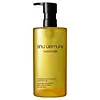What's inside
What's inside
 Key Ingredients
Key Ingredients

 Benefits
Benefits

 Concerns
Concerns

 Ingredients Side-by-side
Ingredients Side-by-side

Isopropyl Palmitate
EmollientPentaerythrityl Tetraethylhexanoate
EmollientPolybutene
PEG-20 Glyceryl Triisostearate
EmollientIsohexadecane
EmollientPEG-8 Diisostearate
EmulsifyingAleurites Moluccanus Seed Oil
Skin ConditioningPEG-12 Diisostearate
EmulsifyingTocopherol
AntioxidantLimnanthes Alba Seed Oil
Skin ConditioningOlea Europaea Fruit Oil
MaskingHelianthus Annuus Seed Oil
EmollientMethyldihydrojasmonate
MaskingSimmondsia Chinensis Seed Oil
EmollientJasminum Officinale Flower Wax
EmollientCalophyllum Inophyllum Seed Oil
AntimicrobialCamellia Japonica Seed Oil
EmollientLavandula Hybrida Oil
EmollientLavandula Angustifolia Oil
MaskingBisabolol
MaskingGlycerin
HumectantGlyceryl Laurate
EmollientWater
Skin ConditioningPentylene Glycol
Skin ConditioningDipentaerythrityl Tri-Polyhydroxystearate
EmollientLinalyl Acetate
MaskingTocopheryl Acetate
AntioxidantIsopropyl Palmitate, Pentaerythrityl Tetraethylhexanoate, Polybutene, PEG-20 Glyceryl Triisostearate, Isohexadecane, PEG-8 Diisostearate, Aleurites Moluccanus Seed Oil, PEG-12 Diisostearate, Tocopherol, Limnanthes Alba Seed Oil, Olea Europaea Fruit Oil, Helianthus Annuus Seed Oil, Methyldihydrojasmonate, Simmondsia Chinensis Seed Oil, Jasminum Officinale Flower Wax, Calophyllum Inophyllum Seed Oil, Camellia Japonica Seed Oil, Lavandula Hybrida Oil, Lavandula Angustifolia Oil, Bisabolol, Glycerin, Glyceryl Laurate, Water, Pentylene Glycol, Dipentaerythrityl Tri-Polyhydroxystearate, Linalyl Acetate, Tocopheryl Acetate
Zea Mays Germ Oil
EmollientEthylhexyl Palmitate
EmollientIsopropyl Myristate
EmollientCaprylic/Capric/Succinic Triglyceride
EmollientPolyglyceryl-6 Dioleate
EmulsifyingPolyglyceryl-6 Dicaprate
EmulsifyingPrunus Armeniaca Kernel Oil
MaskingPolyglyceryl-2 Oleate
EmulsifyingPolyglyceryl-6 Caprylate
EmulsifyingLavandula Hybrida Oil
EmollientLimonene
PerfumingCitrus Nobilis Peel Oil
MaskingPelargonium Graveolens Flower Oil
MaskingLinalool
PerfumingCupressus Sempervirens Leaf/Nut/Stem Oil
EmollientTocopherol
AntioxidantCitronellol
PerfumingCitrus Limon Peel Oil
MaskingGeraniol
PerfumingOriganum Majorana Leaf Oil
MaskingZingiber Officinale Root Oil
MaskingMentha Piperita Oil
MaskingCitral
PerfumingWater
Skin ConditioningDicaprylyl Ether
EmollientDicaprylyl Carbonate
EmollientUndecane
EmollientCymbopogon Schoenanthus Oil
MaskingGlycine Soja Oil
EmollientTridecane
PerfumingGlyceryl Stearate Citrate
EmollientOryza Sativa Bran Oil
EmollientMaltodextrin
AbsorbentCitrus Junos Fruit Extract
Skin ConditioningHelianthus Annuus Seed Oil
EmollientZea Mays Germ Oil, Ethylhexyl Palmitate, Isopropyl Myristate, Caprylic/Capric/Succinic Triglyceride, Polyglyceryl-6 Dioleate, Polyglyceryl-6 Dicaprate, Prunus Armeniaca Kernel Oil, Polyglyceryl-2 Oleate, Polyglyceryl-6 Caprylate, Lavandula Hybrida Oil, Limonene, Citrus Nobilis Peel Oil, Pelargonium Graveolens Flower Oil, Linalool, Cupressus Sempervirens Leaf/Nut/Stem Oil, Tocopherol, Citronellol, Citrus Limon Peel Oil, Geraniol, Origanum Majorana Leaf Oil, Zingiber Officinale Root Oil, Mentha Piperita Oil, Citral, Water, Dicaprylyl Ether, Dicaprylyl Carbonate, Undecane, Cymbopogon Schoenanthus Oil, Glycine Soja Oil, Tridecane, Glyceryl Stearate Citrate, Oryza Sativa Bran Oil, Maltodextrin, Citrus Junos Fruit Extract, Helianthus Annuus Seed Oil
Ingredients Explained
These ingredients are found in both products.
Ingredients higher up in an ingredient list are typically present in a larger amount.
Helianthus Annuus Seed Oil is the oil derived from the seeds of a Sunflower. Sunflower seed oil is non-fragrant. It is an emollient, meaning it helps to soften the skin.
Sunflower seed oil contains many fatty acids. The fatty acids found in sunflower seeds include (from highest amount to least): linoleic acid, myristic acid, palmitic acid, stearic acid, arachidic acid, oleic acid, and linolenic acid.
These fatty acids help the skin create ceramides. Ceramides play a role in repairing the skin barrier.
Helianthus Annuus Seed Oil helps moisturize the skin. This in turn helps the skin look more rejuvenated and smoother.
Sunflowers are rich in vitamin E.
Historians believe Indigenous cultures of North America domesticated sunflowers before corn. Thus they relied on sunflower oil for a variety of uses. One such use is moisturizing skin and hair.
Sunflower seed oil may not be fungal acne safe. We recommend speaking with a professional if you have any concerns.
Learn more about Helianthus Annuus Seed OilLavandula Hybrida Oil is an oil.
Tocopherol (also known as Vitamin E) is a common antioxidant used to help protect the skin from free-radicals and strengthen the skin barrier. It's also fat soluble - this means our skin is great at absorbing it.
Vitamin E also helps keep your natural skin lipids healthy. Your lipid skin barrier naturally consists of lipids, ceramides, and fatty acids. Vitamin E offers extra protection for your skin’s lipid barrier, keeping your skin healthy and nourished.
Another benefit is a bit of UV protection. Vitamin E helps reduce the damage caused by UVB rays. (It should not replace your sunscreen). Combining it with Vitamin C can decrease sunburned cells and hyperpigmentation after UV exposure.
You might have noticed Vitamin E + C often paired together. This is because it is great at stabilizing Vitamin C. Using the two together helps increase the effectiveness of both ingredients.
There are often claims that Vitamin E can reduce/prevent scarring, but these claims haven't been confirmed by scientific research.
Learn more about TocopherolWater. It's the most common cosmetic ingredient of all. You'll usually see it at the top of ingredient lists, meaning that it makes up the largest part of the product.
So why is it so popular? Water most often acts as a solvent - this means that it helps dissolve other ingredients into the formulation.
You'll also recognize water as that liquid we all need to stay alive. If you see this, drink a glass of water. Stay hydrated!
Learn more about Water